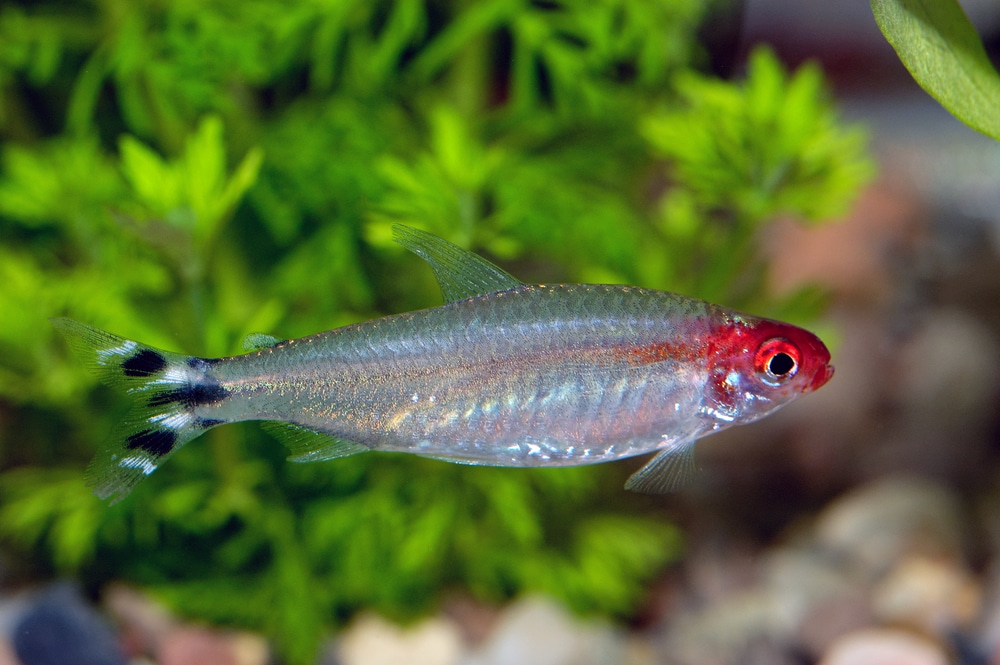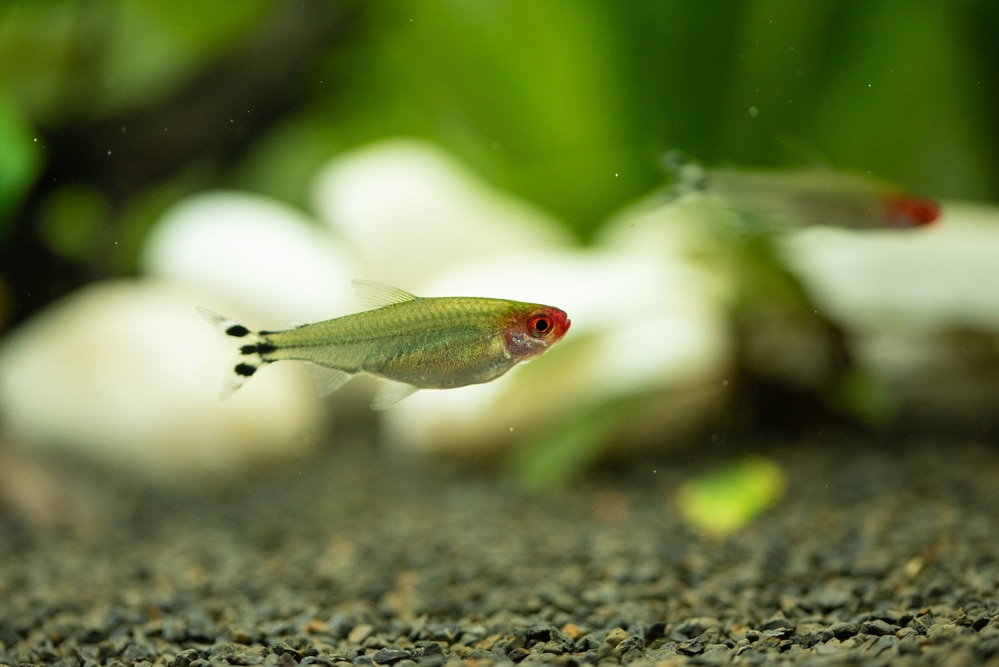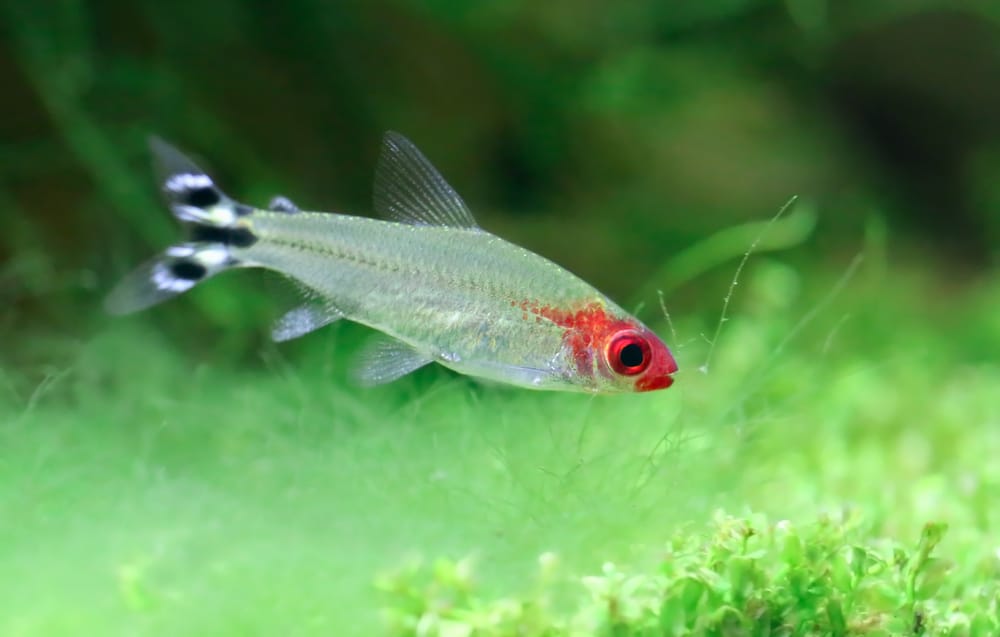Boldin color yet shy in temperament, Rummy Nose Tetras are a favorite fish of mine. They form beautiful schools that stand out in any planted tank and are peaceful, model community dwellers.
If you’re looking for something a little different from Neon Tetras, consider picking up a school of these remarkable relations of theirs!
What are Rummy Nose Tetras?
Rummy Nose Tetras are intriguing little fish that are common in pet stores but not nearly as popular as they should be. Since they are often stressed in crowded, brightly lit aquarium store conditions they rarely look as beautiful as they do once settled into a mature planted tank.
In your planted tank the pale red of their noses takes on a fiery intensity that beautifully matches the sharp black and white striping of their tails.
There is a little bit of confusion involving the name “Rummy Nose Tetra” because there are three closely related species that use it! The “true” Rummy Nose Tetra is Hemigrammus rhodostomus and is the most common species in the trade.
But sometimes you’ll see the Firehead Tetra, H. bleheri, sold as Rummy Nose Tetra. They look almost identical at a quick glance but the Firehead Tetra’s red extends all the way past the gills. In Rummy Nose Tetras the red barely leaves the mouth and nose.
The False Rummy Nose Tetra (Petitella georgiae) also shows up but is much rarer. You can identify these fish by their tail fin striping. The central black stripe extends into the meat of the tail in P. georgiae but ends with the fin itself in H. rhodostomus.
That said, all three tetras have identical care requirements. So regardless of which fish you end up with the following information applies!
- Common Name: Rummy Nose Tetra, Firehead Tetra
- Scientific Name: Hemigrammus rhodostomus (+ H. bleheri & Petitella georgiae)
- Origin: Amazon Basin, South America
- Length: 2-3 inches
- Aquarium Size: 20 gallons
- Temperament: Peaceful; Schooling
- Ease of Care: Easy

Caring for the Rummy Nose Tetra
The section cover Rummy nose tetra care topics such as required tank size, diet, water parameters, and more.
Aquarium Size
Rummy Nose Tetras are small community fish however they aren’t true nano fish. Since they grow 2-3 inches in length I recommend at least a 20 gallon aquarium for a small school of 6 individuals.
The true Rummy Nose Tetra (H. rhodostomus) is the smallest, rarely growing larger than 2 inches. Both of the other two species can reach 3 inches, however.
All three types are highly social and prefer being kept in even larger groups when possible. If there’s less than 6 individuals in a tank they act as if they are under threat, lose color, and remain shy.
Water Quality
Rummy Nose Tetras come from South America. The blackwater streams and pools of Brazil, Venezuela, Colombia, and other near-equatorial regions are where they call home. Temperatures stay elevated from 78-84℉ and the pH is extremely low.
In blackwater environments it can get as low as pH 4.0 and nearly no measurable hardness. These waters tend to flow through flooded forests and grasslands. Decaying plant matter adds humic acids and tannins to the water, staining it a tea color and further buffering it towards acidity.
While it’s not strictly necessary for tank bred Rummy Nose Tetras I highly recommend keeping a bottle on hand to add after water changes. Aquarium driftwood and plant debris also add tannins but not in the amounts needed for good health.
If you’re buying tank bred tetras they are much hardier in neutral to even slightly alkaline conditions (pH 7.0+). However they are much hardier when kept in acidic conditions.
Rummy Nose Tetras exhibit an interesting color change when stressed: the red in their faces grows paler in intensity. Seeing your fish a pale red is a sign that something is amiss, be it aggressive tank mates, poor water conditions, or some other factor. You can treat them like canaries in a coal mine.
Wild-caught Rummy Nose Tetras are a little bit sensitive compared to other fish, especially to ammonia and nitrate. However the majority are tank bred and more tolerant of poor water conditions.
That said, you should aim for 0ppm for all nitrogenous waste products. High ammonia levels in particular are very toxic to aquarium fish.

Plants & Substrate
Rummy Nose Tetras are some of the best fish to keep in planted aquariums. They are small, don’t dig or eat plants, and their colors naturally contrast well with green plant tones.
I recommend choosing plants that can live in the Amazonian conditions these tetras prefer. Most plants prefer things a little cooler, so choose types that do well alongside Discus or Angelfish, two other warm water tropicals.
Amazon Sword Plants, Hygrophila sp., and Micro Sword plants are just a few of the many plants that will grow nicely for you. Most of these plants grow fast but need at least moderate lighting, making full spectrum lights essential to their health.
If you don’t want to invest in higher quality lights stick to low light plants like Java Fern, Java Moss, and Anubias. These plants can grow under standard hood lights and don’t even require fertilizers. They are known as epiphytes, meaning they don’t root in gravel or sand like most plants.
Instead, they can be attached directly to rocks and driftwood. They are some of the best “set and forget” plants for aquarists who don’t want a lot of work but still want things to look green! Thick tangled plants like Java Moss and Guppy Grass also provide Rummy Nose Tetras a natural place to spawn.
Driftwood is also highly recommended. It’s not only beautiful but it leeches tannins into the water, helping to keep the parameters right where the tetras want them.
The substrate is entirely up to you but I recommend choosing a substrate that is made specifically for live plants. A darker colored substrate also ensures your tetras remain deep in coloration. When placed in tanks with pale substrates most fish will wash out their colors to avoid standing out to predators.
Tank Mates for Rummy Nose Tetras
As average sized, peaceful, schooling community fish, Rummy Nose Tetras are very easy to keep with most fish. They tend to keep to themselves and ignore any other fish or invertebrate. They may pick at or even eat baby freshwater shrimp but adult Red Cherry or Bee Shrimp are too large to be threatened by them.
The best tank mates are other fish that thrive in very warm, acidic conditions like they do. Gouramis, Bettas, other Tetras, and smaller Barbs are some of the best choices for a Rummy Nose Tetra tank. Dwarf Cichlids like Apistogramma and Electric Blue Rams come from the same environment and thus get along very well with them.
Many Livebearers, especially Guppies and Endler’s Livebearers do well in slightly acidic conditions as well.
The worst tank mates are aggressive or predatory ones. Large Cichlids and Catfish are obviously out – choose smaller dwarf species like Corydoras. Fish that are normally peaceful but get large like Angelfish can become predatory if they get too much larger than your Tetras.
And while most invertebrates do well with them, stay away from predatory types like Freshwater crabs and Crayfish. They are opportunists that will snatch and eat small sleeping fish if they can.
Good Tank Mates for Rummy Nose Tetras
- Gouramis, Bettas, Tetras, Cherry Barbs, and other Soft Water Community Fish
- Guppies and other Livebearers
- Dwarf Cichlids
- Dwarf Pencilfish
- Corydoras & Otocinclus Catfish
- Bumblebee Gobies
- Dwarf Shrimp
- Snails
Poor Tank Mates for Rummy Nose Tetras
- Medium to Large Cichlids & Catfish
- Smaller Predatory Fish (Africa Butterfly Fish, Leaf Fish, etc)
- Goldfish and other Cold Water Fish
- African Cichlids & other Hard Water Fish
- Crayfish
Feeding Rummy Nose Tetras
Rummy Nose Tetras are what’s called micro predators. In nature they eat tiny animals such as water fleas, insect larvae, fish fry, and anything else free swimming in the water column. They are adaptable and will eat any prepared food you offer that’s the right size. Standard flake food and micro pellets are a great base to work with!
But if you want the best color and possible spawning behavior you’ll need to supplement it with frozen or live food. Brine shrimp (both adults and larvae), blood worms, daphnia, tubifex, and other treats are exactly what they’d seek out in the wild.
Keep an eye on the ingredients labels of your prepared food as well. Avoid brands that use too much wheat, potato starch, and other fillers that carnivorous fish can’t really digest. Animal protein like fish, shrimp, and even insects are far healthier for them, just as whole foods are better for us!
In a mature planted aquarium small worms, seed shrimp, and other micro invertebrates also tend to grow. This provides more natural food for Rummy Nose Tetras to thrive on!

Breeding Rummy Nose Tetras
Tetras in general are fairly challenging to breed in captivity but Rummy Nose Tetras are one of the easier species. Tetras won’t typically spawn unless you get the water conditions exactly the way they like things: soft, acidic, and free of ammonia, nitrite, and nitrates. This goes for both tank bred and wild caught fish.
However, if you provide the right conditions you’re very likely to see eggs at one point or another. Sexing Rummy Nose Tetras can be a bit of a challenge as males and females are identical in coloration.
Fortunately, luck is on your side! Since you’ll have a school of them you’d have to be very unlucky to get all males or all female Rummy Nose Tetras. Raising a young group of them together ensures you’ll get a few that pair off naturally.
Female Rummy Nose Tetras are the most distinctive. Their body cavities swell as they mature, to make space for their ovaries. Even when not full of ripened eggs they are slightly heftier than male Rummy Nose Tetras.
The difference is subtle unless you have a group of mature fish to study. Since they aren’t territorial or aggressive there are no behavioral cues to go by. You simply need to raise your fish to sexual maturity (roughly 1 year in age) and condition your fish to spawn.
If you’re interested in a detailed explanation with visual examples of how males and females differ, take a look at this excellent video on sexing and breeding Rummy Nose Tetras!
Since Rummy Nose Tetras offer additional challenges to breeding, I suggest setting up a breeding tank for these egg scatterers if you want to raise the fry!
Setting Up a Breeding Tank for Rummy Nose Tetras
Like all Tetras, Rummy Noses are egg scatterers. This means that the parents provide no care for the fry. They simply dash in among the plants and release their gametes (eggs and sperm) into the water column.
Their eggs are sticky and adhere to whatever surface they come to first, be it plants, stones, your filter, etc. Therefore, you can make your job a lot easier in one of two ways. You can provide thick live or fake plants that are attractive enough for them to spawn on or set up a separate breeding aquarium.
Guppy Grass, Hornwort, and other thickly tangled plants are ideal if you prefer live plants. You can also trim them once the eggs have been laid and simply toss them into a breeder tank where the trimmings will continue to grow as floating plants.
If you’re not a fan of using live plants, plastic spawning mops simulate the fine feathered texture of the real deal. Your Rummy Nose Tetras will gravitate towards them to spawn and the plastic versions are easily detached and moved to a new tank.
I also recommend moving the eggs or spawn-ready Tetras to a breeder tank because like most egg scatterers, they quickly forget about their young. After a few hours they revert back to normal behavior and will readily eat their eggs and fry.
Once the eggs have been laid they will hatch within 24-48 hours, assuming they are fertile. The young are extremely tiny and may remain on the bottom for up to six days, feeding on their yolk sac.
As soon as the fry become free swimming it’s time to begin feeding them. Since newly hatched Rummy Nose Tetras are too small for brine shrimp nauplii you’ll need to culture infusoria ahead of time.
Infusoria is a fancy word for “cloudy pond water:” it’s a homemade culture of microorganisms, including paramecia, amoebas, and bacteria. That’s how tiny these fry are – anything larger is too much for them to handle.
Within a few weeks, however, they will grow large enough to begin feeding on brine shrimp nauplii, micro worms, and other slightly less tiny food items. Fortunately, setting up a brine shrimp hatchery so you have a constant supply of nauplii is very easy to do!
Eventually, the young will grow large enough that you can either move them in with the adults or resell them back to your local fish store!

